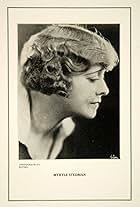Myrtle Stedman(1885-1938)
- Actress
- Writer
Born in Chicago in 1885, silent screen actress Myrtle Stedman's (née
Lincoln) musical talents developed quite early, finding herself on
stage at age 12 singing light opera in the chorus. She had progressed
to singing leads in shows by the time she decided to abandon her music
career altogether for the movies.
She and actor-husband Marshall Stedman were signed by the Selig Polyscope Co. in 1911 and Myrtle's first credit was The Two Orphans (1911), a three-reeler. She was often directed or paired up with Marshall during those early years, but Myrtle was the one who stood out with moviegoers. Known as "the girl with the pearly eyes," she was not only an adorably enchanting and enigmatic presence in film drama, her athletic abilities also complemented westerns and action adventures.
She moved to the Bosworth Company in 1914 and appeared in such noteworthy silents as The Country Mouse (1914), Jane (1915), Peer Gynt (1915), and, most notably, the classic Hypocrites (1915), the last helmed by pioneer lady director Lois Weber. She increased her reputation as a fine actress with The American Beauty (1916), As Men Love (1917), In the Hollow of Her Hand (1918) and The Teeth of the Tiger (1919). Her son, Lincoln Stedman, made his debut as a juvenile player about this time. She and her husband divorced in 1919.
Following her rich roles in Reckless Youth (1922) and The Famous Mrs. Fair (1923), which was considered one of her finest, her star began to fade and she began to support other stars such as Colleen Moore in Flaming Youth (1923); May McAvoy in Tessie (1925); and Mary Astor in No Place to Go (1927).
Come the advent of sound, Myrtle seemed to move with ease into matronly secondary roles in such films as The Jazz Age (1929), Little Accident (1930), Beau Ideal (1931), Klondike (1932) and The Widow in Scarlet (1932), but by 1933, she had regressed to unbilled roles and pretty much stayed in that capacity up until the time of her death. Myrtle suffered a heart attack in late 1937 and declined quickly, dying on January 8, 1938 at age 52. Her ex-husband died in 1943 and her son, Lincoln, died in 1948.
She and actor-husband Marshall Stedman were signed by the Selig Polyscope Co. in 1911 and Myrtle's first credit was The Two Orphans (1911), a three-reeler. She was often directed or paired up with Marshall during those early years, but Myrtle was the one who stood out with moviegoers. Known as "the girl with the pearly eyes," she was not only an adorably enchanting and enigmatic presence in film drama, her athletic abilities also complemented westerns and action adventures.
She moved to the Bosworth Company in 1914 and appeared in such noteworthy silents as The Country Mouse (1914), Jane (1915), Peer Gynt (1915), and, most notably, the classic Hypocrites (1915), the last helmed by pioneer lady director Lois Weber. She increased her reputation as a fine actress with The American Beauty (1916), As Men Love (1917), In the Hollow of Her Hand (1918) and The Teeth of the Tiger (1919). Her son, Lincoln Stedman, made his debut as a juvenile player about this time. She and her husband divorced in 1919.
Following her rich roles in Reckless Youth (1922) and The Famous Mrs. Fair (1923), which was considered one of her finest, her star began to fade and she began to support other stars such as Colleen Moore in Flaming Youth (1923); May McAvoy in Tessie (1925); and Mary Astor in No Place to Go (1927).
Come the advent of sound, Myrtle seemed to move with ease into matronly secondary roles in such films as The Jazz Age (1929), Little Accident (1930), Beau Ideal (1931), Klondike (1932) and The Widow in Scarlet (1932), but by 1933, she had regressed to unbilled roles and pretty much stayed in that capacity up until the time of her death. Myrtle suffered a heart attack in late 1937 and declined quickly, dying on January 8, 1938 at age 52. Her ex-husband died in 1943 and her son, Lincoln, died in 1948.

























